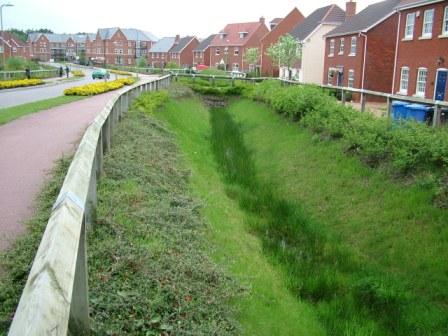Sustainable Urban Drainage Systems (SUDS)
Sustainable Urban Drainage Systems (SUDS) are a set of techniques designed to manage the surface water runoff from urban areas in a sustainable manner. SUDS aim to mimic natural water management systems by allowing water to infiltrate into the ground, evaporate, or be used by vegetation, rather than being rapidly channeled into drains and then into rivers or seas.
Some examples of SUDS techniques include:
- Permeable surfaces: This involves using materials that allow water to infiltrate into the ground, such as porous pavements, permeable concrete, or gravel.
- Green roofs: This involves creating vegetation-covered roofs that can absorb rainwater and reduce runoff.
- Rain gardens: This involves planting gardens or landscaping features that can absorb and filter runoff water.
- Swales: This involves creating shallow ditches or channels that can slow down and filter runoff water.
- Sustainable drainage ponds: This involves creating ponds or wetlands that can absorb and treat runoff water.
The benefits of SUDS include reducing the risk of flooding, improving water quality, enhancing biodiversity, and providing green space in urban areas. Additionally, SUDS can help reduce the need for expensive and energy-intensive drainage systems, while also reducing the amount of water that needs to be treated at sewage treatment plants.
For the outline and full planning permission requirements, the applicant should provide the following as part of the SuDS drainage:
- Calculations for the existing and post developed site runoff volumes for the 1 in 100 year 6 hour storm event;
- Calculations for the storage requirements of the 1 in 100 year + Climate Change storm event;
- Calculations of the proposed attenuation storage volumes for all SuDS features;
- Calculations demonstrating the site does not flood for events up to the 1 in 30 year storm event;
- Analysis of storage requirements to demonstrate they meet the above standards;
- Calculations and analysis of long term storage requirements for the site; and
- Long term storage requirement – an assessment should be made of long term storage requirements if the site is greater than 1ha:
- For greenfield sites, calculations of the 1 in 100 year 6 hour storm event greenfield runoff volume and the volume of runoff generated by the proposed development for the same event should be provided;
- For brownfield sites, calculations of the 1 in 100 year 6 hour storm event pre and post development runoff volumes;
- Confirmation of the proposed on-site storage volume; and,
If adequate storage cannot be provided, clear justification as to why should be outlined within the Drainage Strategy.
